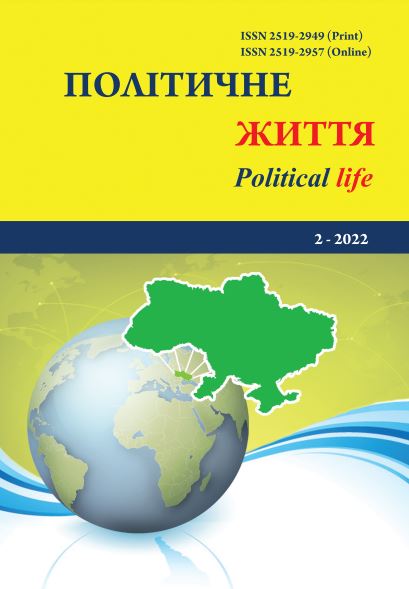Information Dimension of Political Conflicts: Theoretical Approaches and Practical Implementation
DOI:
https://doi.org/10.31558/2519-2949.2022.2.6Keywords:
political information; information action; information conflict; propaganda; warAbstract
The authors attempt to conceptualize the definition of the nature of political information, which includes data on the activities of political parties, institutions, organizations, political leaders; data used in policy making and decision making; data that had a direct or indirect impact on the political behavior of the masses. The main components (substantive and representative), properties of information (ability to influence the psyche, significance (completeness), reliability, integrity, relevance), as well as the classification of information in social systems by purpose (mass, group, individual) were outlined. The authors determined that in the socio-political aspect distorted information is information that, under the influence of certain means, has undergone distortion and transformation of information flows through qualitative changes, as a result of which it begins to negatively affect the political system. The main types of distorted information in comparison with its antipodes – "opposite poles" of information necessary for the proper functioning of specific structural elements of the political system of society were determined.
The article systematizes the types of information action, among which information propaganda, information aggression and information war are singled out. The purposes, tasks, signs of types of information action are defined. The authors note that information warfare is an integral part of political relations and the main tool of political coercion and achievement of political goals. It is noted that the information war is the factor that can significantly change the direction of political processes and lead to a shift in the centers of domestic or foreign policy influence.
The authors emphasize that information warfare is used today as a main tool by states – information investors who are trying to control the global information space.
References
Boulding K. National images and international systems. Journal of conflict resolution. 1959. № 3. P. 120-131.
Deutsch K. The Nerves of Government: Models of Political Communication and Control. New York : The Free Press of Glencoe, 1966. 316 р.
Маркс К. Капитал. Київ : «Видавничий союз Андронум», 2021. 960 с.
Tilly Charles. The Politics of Collective Violence. Cambridge University Press, 2014. URL: https://www.cambridge.org/core/books/politics-of-collective-violence/12FF386A493CDB99418033CA2A234D05
Dahrendorf, Ralf. Life chances: Approaches to Social and Political Theory. London: Weidenfeld and Nicolson, 1979. 181 p.
Coser A. Lewis. Conflict and Consensus. London: Free Pr, 1984. 436 p.
Webster Frank Theories of the Information Society (International Library of Sociology) 4th Edition. London : Routledge, 2014. 416 p.
Примуш М.В., Клюжев О.В. Політична Конфліктологія: теорія і практика: навч. посіб. Донецьк, 2011. 144 с.
Осмоловська А.О. Політика формування іміджу України в інформаційному просторі закордонних держав після 2014 р. : дис. … д-ра філ. : 052 «Політологія». Вінниця, 2021. 252 с.

